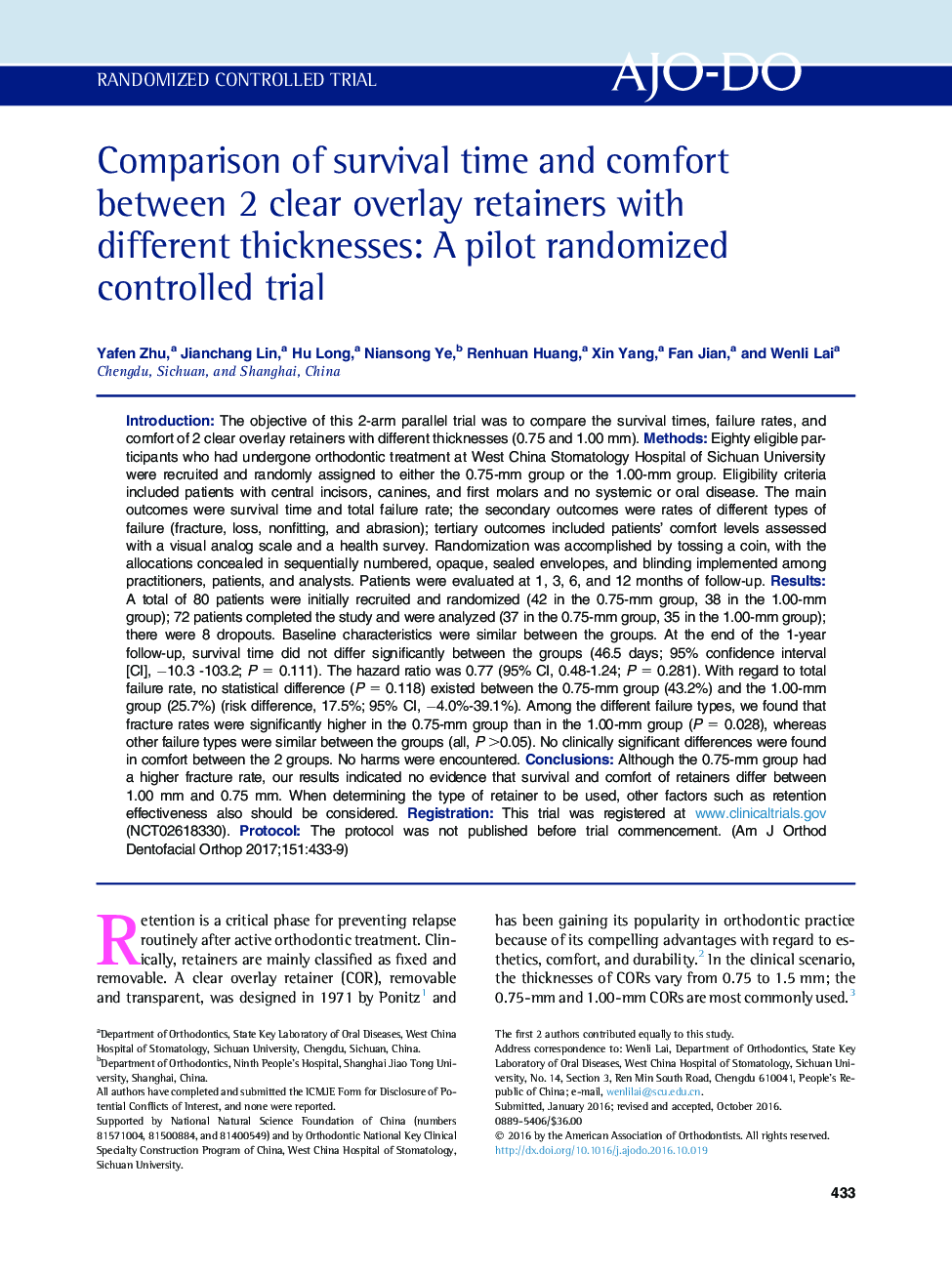| کد مقاله | کد نشریه | سال انتشار | مقاله انگلیسی | نسخه تمام متن |
|---|---|---|---|---|
| 5637711 | 1582666 | 2017 | 7 صفحه PDF | دانلود رایگان |
- We conducted a randomized trial to compare clear retainers with 2 thicknesses.
- Survival times were similar in the 0.75-mm and 1.00-mm retainer groups.
- Total failure rate difference between the 2 groups was statistically insignificant.
- Fracture rate was significantly higher in the 0.75-mm than in the 1.00-mm group.
- No significant clinical difference was found in comfort between the 2 groups.
IntroductionThe objective of this 2-arm parallel trial was to compare the survival times, failure rates, and comfort of 2 clear overlay retainers with different thicknesses (0.75 and 1.00 mm).MethodsEighty eligible participants who had undergone orthodontic treatment at West China Stomatology Hospital of Sichuan University were recruited and randomly assigned to either the 0.75-mm group or the 1.00-mm group. Eligibility criteria included patients with central incisors, canines, and first molars and no systemic or oral disease. The main outcomes were survival time and total failure rate; the secondary outcomes were rates of different types of failure (fracture, loss, nonfitting, and abrasion); tertiary outcomes included patients' comfort levels assessed with a visual analog scale and a health survey. Randomization was accomplished by tossing a coin, with the allocations concealed in sequentially numbered, opaque, sealed envelopes, and blinding implemented among practitioners, patients, and analysts. Patients were evaluated at 1, 3, 6, and 12 months of follow-up.ResultsA total of 80 patients were initially recruited and randomized (42 in the 0.75-mm group, 38 in the 1.00-mm group); 72 patients completed the study and were analyzed (37 in the 0.75-mm group, 35 in the 1.00-mm group); there were 8 dropouts. Baseline characteristics were similar between the groups. At the end of the 1-year follow-up, survival time did not differ significantly between the groups (46.5 days; 95% confidence interval [CI], â10.3 -103.2; P = 0.111). The hazard ratio was 0.77 (95% CI, 0.48-1.24; P = 0.281). With regard to total failure rate, no statistical difference (P = 0.118) existed between the 0.75-mm group (43.2%) and the 1.00-mm group (25.7%) (risk difference, 17.5%; 95% CI, â4.0%-39.1%). Among the different failure types, we found that fracture rates were significantly higher in the 0.75-mm group than in the 1.00-mm group (P = 0.028), whereas other failure types were similar between the groups (all, P >0.05). No clinically significant differences were found in comfort between the 2 groups. No harms were encountered.ConclusionsAlthough the 0.75-mm group had a higher fracture rate, our results indicated no evidence that survival and comfort of retainers differ between 1.00 mm and 0.75 mm. When determining the type of retainer to be used, other factors such as retention effectiveness also should be considered.RegistrationThis trial was registered at www.clinicaltrials.gov (NCT02618330).ProtocolThe protocol was not published before trial commencement.
Journal: American Journal of Orthodontics and Dentofacial Orthopedics - Volume 151, Issue 3, March 2017, Pages 433-439
